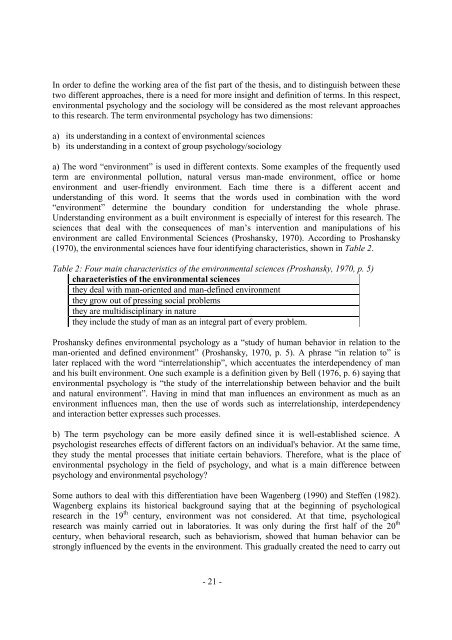Perception Aspects in Underground Spaces using ... - TOI - TU Delft
Perception Aspects in Underground Spaces using ... - TOI - TU Delft
Perception Aspects in Underground Spaces using ... - TOI - TU Delft
You also want an ePaper? Increase the reach of your titles
YUMPU automatically turns print PDFs into web optimized ePapers that Google loves.
In order to def<strong>in</strong>e the work<strong>in</strong>g area of the fist part of the thesis, and to dist<strong>in</strong>guish between thesetwo different approaches, there is a need for more <strong>in</strong>sight and def<strong>in</strong>ition of terms. In this respect,environmental psychology and the sociology will be considered as the most relevant approachesto this research. The term environmental psychology has two dimensions:a) its understand<strong>in</strong>g <strong>in</strong> a context of environmental sciencesb) its understand<strong>in</strong>g <strong>in</strong> a context of group psychology/sociologya) The word “environment” is used <strong>in</strong> different contexts. Some examples of the frequently usedterm are environmental pollution, natural versus man-made environment, office or homeenvironment and user-friendly environment. Each time there is a different accent andunderstand<strong>in</strong>g of this word. It seems that the words used <strong>in</strong> comb<strong>in</strong>ation with the word“environment” determ<strong>in</strong>e the boundary condition for understand<strong>in</strong>g the whole phrase.Understand<strong>in</strong>g environment as a built environment is especially of <strong>in</strong>terest for this research. Thesciences that deal with the consequences of man’s <strong>in</strong>tervention and manipulations of hisenvironment are called Environmental Sciences (Proshansky, 1970). Accord<strong>in</strong>g to Proshansky(1970), the environmental sciences have four identify<strong>in</strong>g characteristics, shown <strong>in</strong> Table 2.Table 2: Four ma<strong>in</strong> characteristics of the environmental sciences (Proshansky, 1970, p. 5)characteristics of the environmental sciencesthey deal with man-oriented and man-def<strong>in</strong>ed environmentthey grow out of press<strong>in</strong>g social problemsthey are multidiscipl<strong>in</strong>ary <strong>in</strong> naturethey <strong>in</strong>clude the study of man as an <strong>in</strong>tegral part of every problem.Proshansky def<strong>in</strong>es environmental psychology as a “study of human behavior <strong>in</strong> relation to theman-oriented and def<strong>in</strong>ed environment” (Proshansky, 1970, p. 5). A phrase “<strong>in</strong> relation to” islater replaced with the word “<strong>in</strong>terrelationship”, which accentuates the <strong>in</strong>terdependency of manand his built environment. One such example is a def<strong>in</strong>ition given by Bell (1976, p. 6) say<strong>in</strong>g thatenvironmental psychology is “the study of the <strong>in</strong>terrelationship between behavior and the builtand natural environment”. Hav<strong>in</strong>g <strong>in</strong> m<strong>in</strong>d that man <strong>in</strong>fluences an environment as much as anenvironment <strong>in</strong>fluences man, then the use of words such as <strong>in</strong>terrelationship, <strong>in</strong>terdependencyand <strong>in</strong>teraction better expresses such processes.b) The term psychology can be more easily def<strong>in</strong>ed s<strong>in</strong>ce it is well-established science. Apsychologist researches effects of different factors on an <strong>in</strong>dividual's behavior. At the same time,they study the mental processes that <strong>in</strong>itiate certa<strong>in</strong> behaviors. Therefore, what is the place ofenvironmental psychology <strong>in</strong> the field of psychology, and what is a ma<strong>in</strong> difference betweenpsychology and environmental psychology?Some authors to deal with this differentiation have been Wagenberg (1990) and Steffen (1982).Wagenberg expla<strong>in</strong>s its historical background say<strong>in</strong>g that at the beg<strong>in</strong>n<strong>in</strong>g of psychologicalresearch <strong>in</strong> the 19 th century, environment was not considered. At that time, psychologicalresearch was ma<strong>in</strong>ly carried out <strong>in</strong> laboratories. It was only dur<strong>in</strong>g the first half of the 20 thcentury, when behavioral research, such as behaviorism, showed that human behavior can bestrongly <strong>in</strong>fluenced by the events <strong>in</strong> the environment. This gradually created the need to carry out- 21 -





